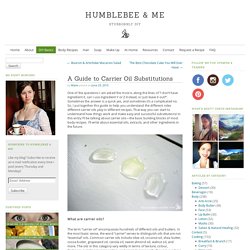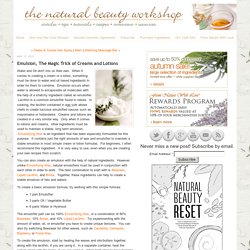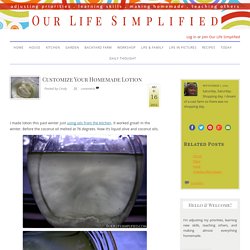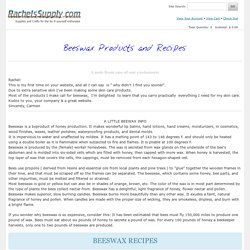

Lotion calculator. A Guide to Carrier Oil Substitutions. One of the questions I am asked the most is along the lines of “I don’t have ingredient X, can I use ingredient Y or Z instead, or just leave it out?”.

Sometimes the answer is a quick yes, and sometimes it’s a complicated no. So, I put together this guide to help you understand the different roles different carrier oils play in different recipes. That way you can start to understand how things work and make easy and successful substitutions! In this entry I’ll be talking about carrier oils—the basic building blocks of most body recipes. I’ll write about essential oils, extracts, and other ingredients in the future. What are carrier oils? The term “carrier oil” encompasses hundreds of different oils and butters. So… what are the variables? Carrier oils serve a variety of purposes. Bulking/DilutingConsistencySpeed of absorptionTexture & melting pointSpecial features & benefits Consistency—The most important purpose after being the base of every recipe is consistency.
Hope that helps! Making lotions and creams. Oils-butters. Organic Lotion Secrets' Natural Homemade Lotion Recipes Tips Percentages conversion calculator temperature Non Toxic. Recipes: Lotions and Creams Lotions and creams are emulsified blends of oil and water made to nourish and moisturize skin.

Most lotions are oil-in-water emulsions, but water-in-oil lotions are also made. Creams are thicker and tend to leave more of a film or residue. Sometimes that's what you are looking for in skin care. It's best if the oil and water mixtures are around the same temperature when combined and warm to hot. Cool down the oil and water mixes slightly before blending so hot liquid and gas do not force themselves out of the blender or bowl and burn you. Use a funnel if you have to and pour your lotion into sterilized containers.
Start simple and write down every recipe that blended perfect, even if you aren't happy with other qualities like scent or color. Keep your new lotion or cream refrigerated until you are ready to use it up. What is pH? PH is short for the power of Hydrogen. Here are some quick reference guidelines: Frequently Asked Questions about Lotions & Creams. Emulsion, The Magic Trick of Creams and Lotions. Water and Oil don't mix on their own.

When it comes to creating a cream or a lotion, something must be done to water and oil based ingredients in order for them to combine. Emulsion occurs when water is allowed to encapsulate oil molecules with the help of a stretchy ingredient called an emulsifier. Lecithin is a common emulsifier found in nature. In cooking, the lecithin contained in egg yolk allows chefs to create luscious emulsified sauces such as mayonnaise or hollandaise. Creams and lotions are created in a very similar way. You can also create an emulsion with the help of natural ingredients. To create a basic emulsion formula, try working with this simple formula: 1 part Emulsifier3 parts Oil / Vegetable Butter6 parts Water or Hydrosol The emulsifier part can be 100% Emulsifying Wax, or a combination of 80% Beeswax, 10% Borax, and 10% Liquid Lecithin.
To create the emulsion, start by heating the waxes and oils/butters together, along with the lecithin, if you are using it. Sbwave lotion calculator. Homemade Beeswax Body Balm - Eve Out of the Garden. Ingredient Ratios for Lotion Making Cheat Sheet by emmajane - Cheatography.com: Cheat Sheets For Every Occasion. Customize Your Homemade Lotion. I made lotion this past winter just using oils from the kitchen.

It worked great! In the winter. Before the coconut oil melted at 76 degrees. Now it’s liquid olive and coconut oils. I have a problem rubbing liquid oil onto my body–it’s a texture thing. So with a couple more ingredients, I’ve been experimenting making homemade lotions–beautiful, creamy white lotion. If you look on the back of a lotion bottle, the manufacturer has already given you all (or most!) All you need is water, glycerin, oils, fragrance (if you wish), a preservative (if you wish), and emulsifying wax. Make your own Natural Beeswax Products. A note from one of our customers: Beeswax is a byproduct of honey production.

It makes wonderful lip balms, hand lotions, hand creams, moisturizers, in cosmetics, wood finishes, waxes, leather polishes; waterproofing products, and dental molds. It is impervious to water and unaffected by mildew. It has a melting point of 143 to 148 degrees F. and should only be heated using a double boiler as it is flammable when subjected to fire and flames. It is pliable at 100 degrees F. Beeswax is produced by the (female) worker honeybees. Bees use propolis ( derived from resins and essential oils from local plants and pine trees ) to "glue" together the wooden frames in their hive, and that must be scraped off so the frames can be separated.
If you wonder why beeswax is so expensive, consider this: It has been estimated that bees must fly 150,000 miles to produce one pound of wax. Moisturing Vitamin E Cream Antiseptic Balm ( Use instead of antiseptic ointment, this is far superior! Rich Hand Cream.